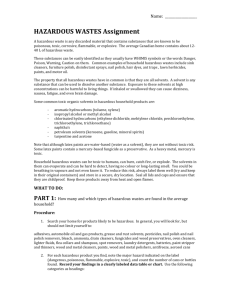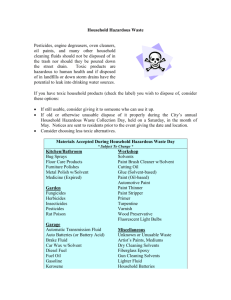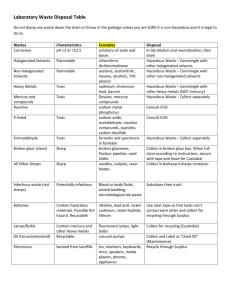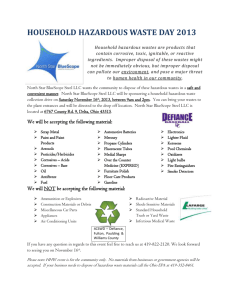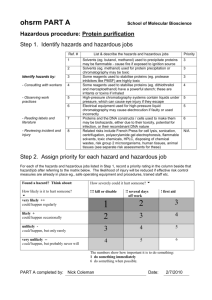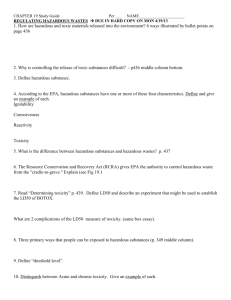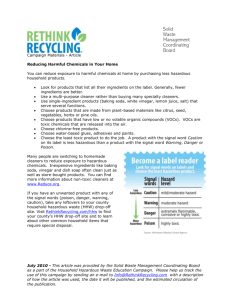HAZARDOUS WASTES
advertisement
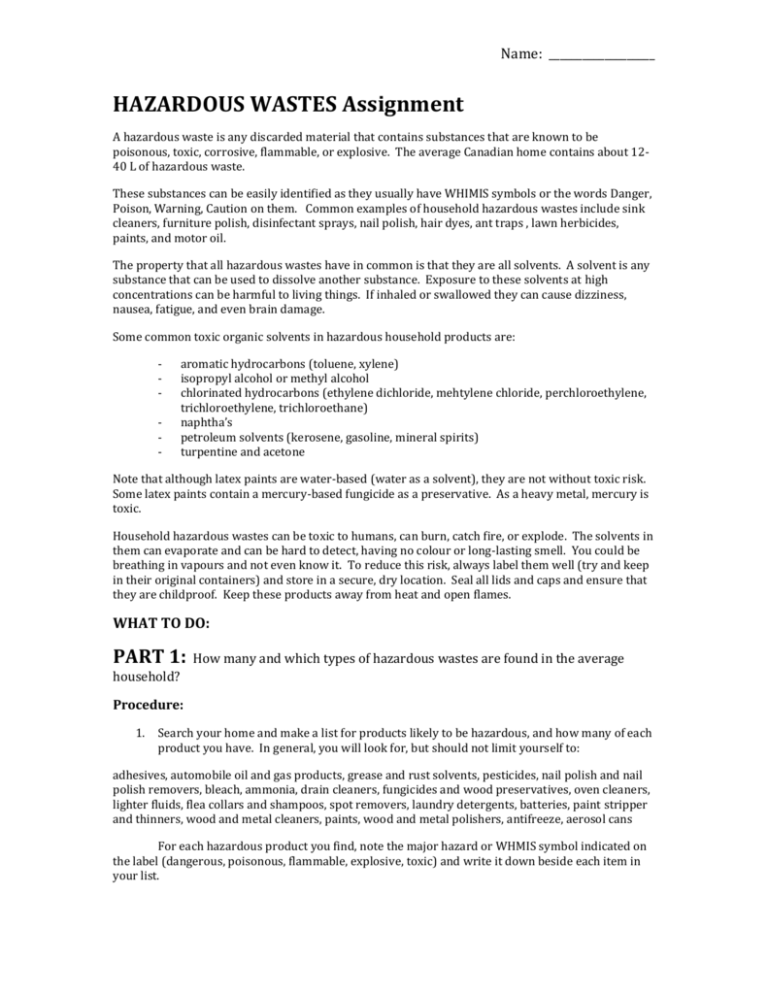
Name: ___________________ HAZARDOUS WASTES Assignment A hazardous waste is any discarded material that contains substances that are known to be poisonous, toxic, corrosive, flammable, or explosive. The average Canadian home contains about 1240 L of hazardous waste. These substances can be easily identified as they usually have WHIMIS symbols or the words Danger, Poison, Warning, Caution on them. Common examples of household hazardous wastes include sink cleaners, furniture polish, disinfectant sprays, nail polish, hair dyes, ant traps , lawn herbicides, paints, and motor oil. The property that all hazardous wastes have in common is that they are all solvents. A solvent is any substance that can be used to dissolve another substance. Exposure to these solvents at high concentrations can be harmful to living things. If inhaled or swallowed they can cause dizziness, nausea, fatigue, and even brain damage. Some common toxic organic solvents in hazardous household products are: - aromatic hydrocarbons (toluene, xylene) isopropyl alcohol or methyl alcohol chlorinated hydrocarbons (ethylene dichloride, mehtylene chloride, perchloroethylene, trichloroethylene, trichloroethane) naphtha’s petroleum solvents (kerosene, gasoline, mineral spirits) turpentine and acetone Note that although latex paints are water-based (water as a solvent), they are not without toxic risk. Some latex paints contain a mercury-based fungicide as a preservative. As a heavy metal, mercury is toxic. Household hazardous wastes can be toxic to humans, can burn, catch fire, or explode. The solvents in them can evaporate and can be hard to detect, having no colour or long-lasting smell. You could be breathing in vapours and not even know it. To reduce this risk, always label them well (try and keep in their original containers) and store in a secure, dry location. Seal all lids and caps and ensure that they are childproof. Keep these products away from heat and open flames. WHAT TO DO: PART 1: How many and which types of hazardous wastes are found in the average household? Procedure: 1. Search your home and make a list for products likely to be hazardous, and how many of each product you have. In general, you will look for, but should not limit yourself to: adhesives, automobile oil and gas products, grease and rust solvents, pesticides, nail polish and nail polish removers, bleach, ammonia, drain cleaners, fungicides and wood preservatives, oven cleaners, lighter fluids, flea collars and shampoos, spot removers, laundry detergents, batteries, paint stripper and thinners, wood and metal cleaners, paints, wood and metal polishers, antifreeze, aerosol cans For each hazardous product you find, note the major hazard or WHMIS symbol indicated on the label (dangerous, poisonous, flammable, explosive, toxic) and write it down beside each item in your list. Name: ___________________ 2. Take the items in your list and summarize them into a data table with the following categories as headings and count how many items you have for each category: (a) paints and adhesives (b) pesticides (c) household cleaners (d) automobile products (e) other (you can create other headings if you feel they fit with your list) Analysis: 1. 2. 3. 4. 5. Which of the five categories contained the most household hazardous produces found in your home? Construct a bar graph illustrating your totals in each of the areas (a) to (e). Would you expect every student in your class to have obtained similar results to yours? Explain your answer. Based on your survey, what hazard category did most containers fall under – Dangerous, Poisonous, Flammable, Explosive, or Toxic? How safely stored were the hazardous products you identified? What are the e consequences of incorrect storage of those products? ***NOTE: Your list, data table and graph should be done on the computer. Microsoft Office or Excel programs work well. Your answers to the Analysis questions should be in full sentences and typed as well. **** PART 2: What are hazards involved in use and storage of paints and adhesives? Procedure: 1. 2. 3. Carefully study the label on one of the paints or adhesives that you found during your survey of your household hazardous wastes. Look at the list of materials in the product. What is the solvent used? After determining the name of the solvent in the chosen product, search the internet for any information about that solvent. You should be able to describe: - what the solvent is - what happens to the solvent when it enters the environment - likely methods of exposure - how that solvent can affect your health - how you might medically determine whether you have been exposed or not - find the LD50 for the solvent (search agency for toxic substances and disease registry ATSDR) Summarize the information you obtained in step 2 in any of the following forms you wish: a poster, a poem or create a website. Analysis: 1. 2. Why is exposure to paint (oil-based or water-based) likely to cause health problems? Why should you avoid contact with solvent-based adhesives? ****NOTE: Your answers to the Analysis questions should be in full sentences and typed as well. Please be thorough in your answers. ****
